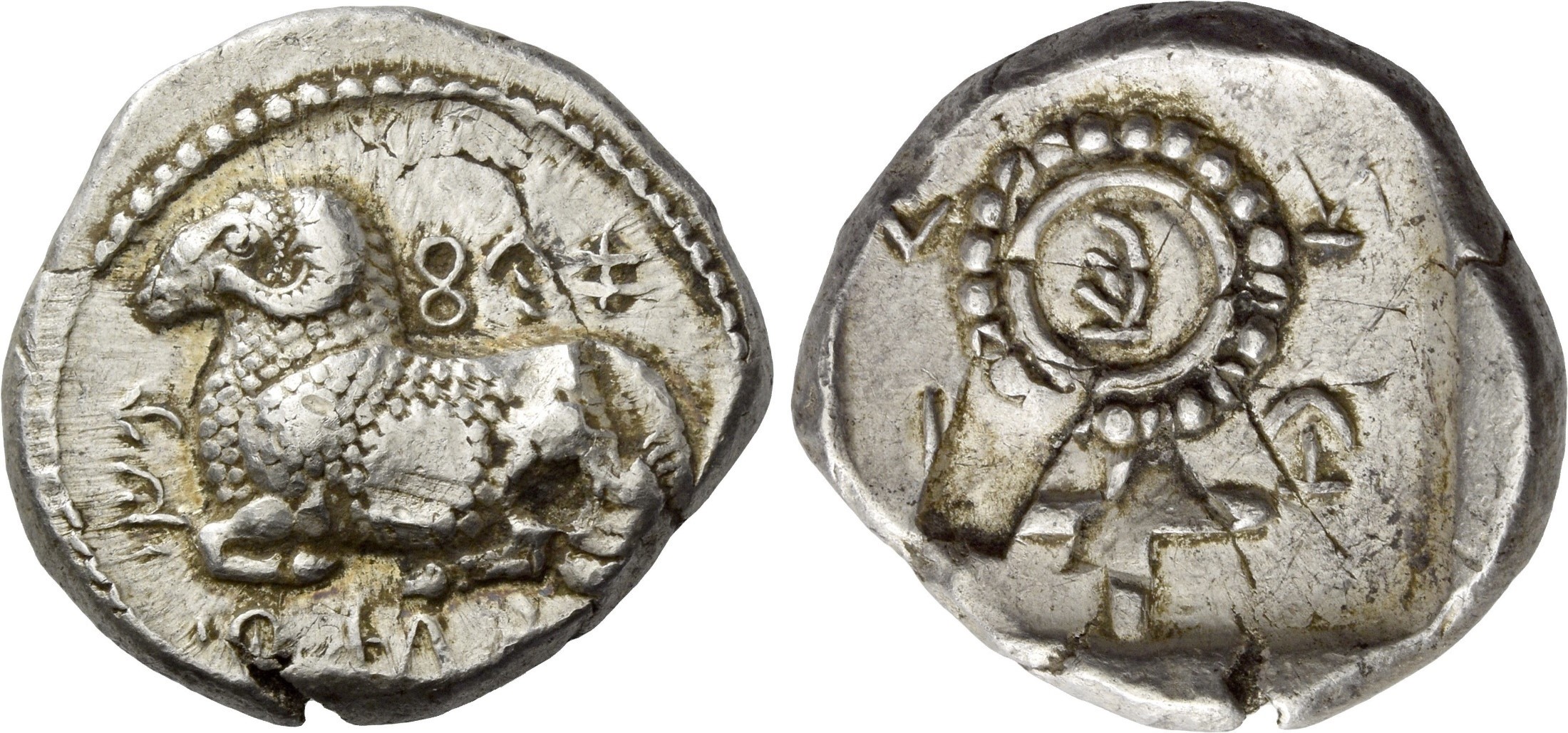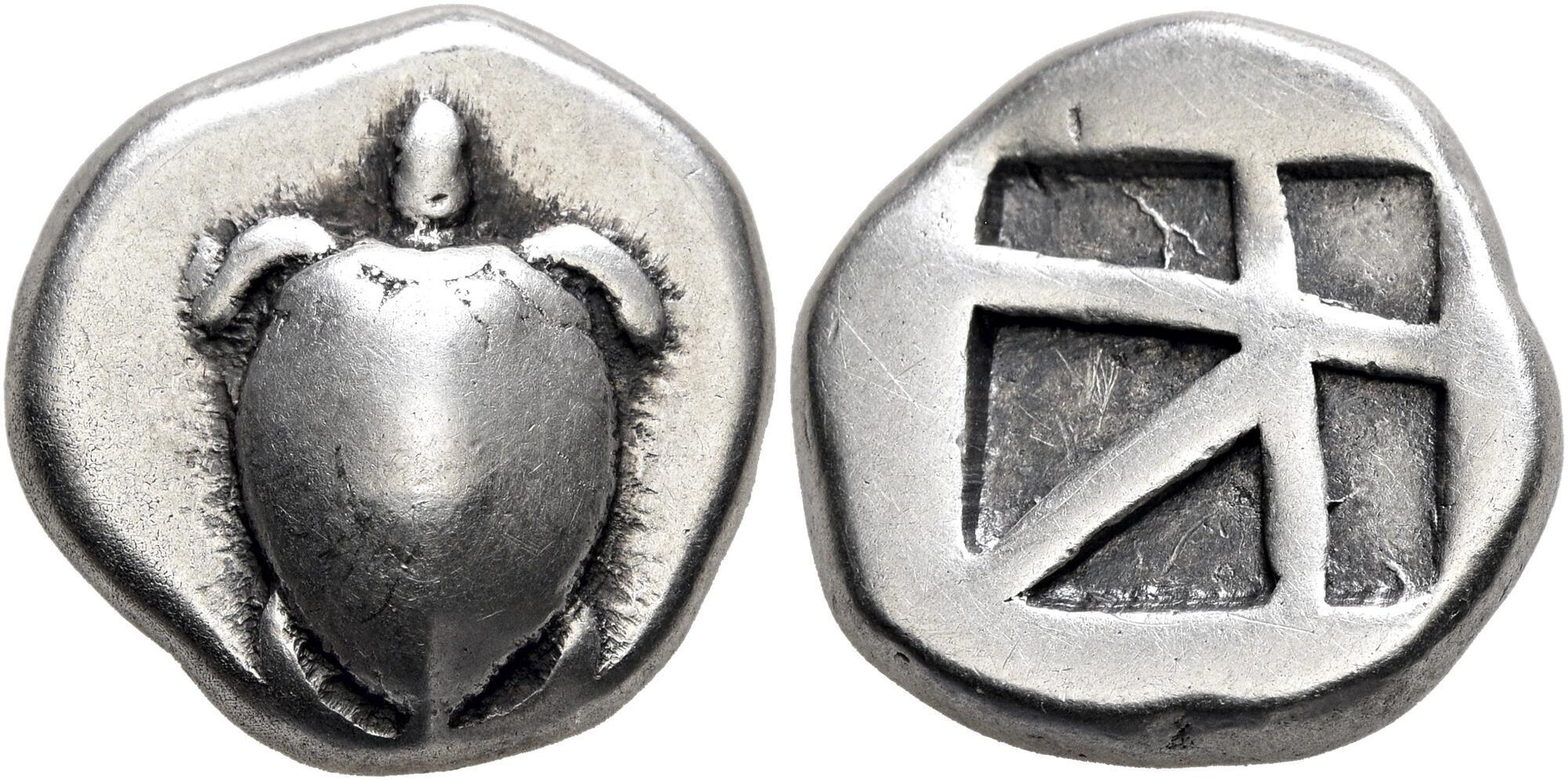460 BCE - 450 BCE"pa-si-le-wo-se/ni-ko" (Cypriot syllabic) | "pa / ni-ko-ta-mo" (Cypriot syllabic)
Overstriking coin
Salamis_1800_NAC.jpg
|
|
Sale(s)Sale(s) ᵖ:
|
Numismatica Ars Classica, 106, 9 May 2018, 310 = Giessener Münzhandlung Dieter Gorny, 69, 1994, 424
|
|
|
Archaeological contextArchaeological context:
|
Hoard from East (Pfisterer A24)
|
Description
| ObverseInscription or printing placed on the obverse.:
|
"pa-si-le-wo-se/ni-ko" (Cypriot syllabic) (Cypriot) Ram lying left.
|
ReverseInscription or printing placed on the reverse.:
|
"pa / ni-ko-ta-mo" (Cypriot syllabic) (Cypriot) Ankh within incuse square.
|
Mint and issuing power
Chronology
| FromIdentifies the initial date in a range assigned in a numismatic context. 460 BCE toIdentifies the final date in a range assigned in a numismatic context.. 450 BCE
|
Classical 480-323 BC  periodTime period of the numismatic object. periodTime period of the numismatic object.
|
Physical description
MetalThe physical material (usually metal) from which an object is made.: Silver 
|
WeightWeight of the numismatic object (in grams). in grams: 11.3211.32 g <br />11,320 mg <br />
|
DenominationTerm indicating the value of a numismatic object. Examples: tetradrachm, chalkous, denarius.: double siglos 
|
|
|
|
StandardStandard.: Persian
|
References
Description
| ObverseInscription or printing placed on the obverse.:
|
Land tortoise with segmented shell (visible on the coin's obverse).
|
ReverseInscription or printing placed on the reverse.:
|
Large square incuse with heavy skew pattern (visible on the coin's reverse : mill-sail reverse pattern).
|
Mint and issuing power
| MintIdentifies the place of manufacture or issue of a numismatic object. ᵖ:
|
Aegina
|
Ancient regionAncient region. ᵖ
|
Attica
|
Modern countryModern country: Greece
|
AuthorityIdentifies the authority in whose name (explicitly or implicitly) a numismatic object was issued. ᵖ:
|
|
Chronology
| FromIdentifies the initial date in a range assigned in a numismatic context. 460 BCE toIdentifies the final date in a range assigned in a numismatic context.. 430 BCE
|
Classical 480-323 BC  periodTime period of the numismatic object. periodTime period of the numismatic object.
|
Physical description
| DenominationTerm indicating the value of a numismatic object. Examples: tetradrachm, chalkous, denarius. ᵖ:
|
stater 
|
StandardStandard. ᵖ:
|
Aeginetic
|
References
References
- ^ Zapiti, Eleni - Michaelidou, Lefki (2008), Coins of Cyprus : from the collection of the Bank of Cyprus Cultural Foundation, Nicosia, Bank of Cyprus Cultural Foundation, 329 p.
- ^ Destrooper-Georgiades, A. (2013), "Monnaies chypriotes surfrappées des cités-royaumes," in Demetrios Michaelides (ed.), Epigraphy, numismatics, prosopography and History of Ancient Cyprus. Papers in honour of Ino Nicolaou, Studies in Mediterranean Archaeology and Literature PB 179, Uppsala, p. 9-40.
- ^ Hoover, Oliver D. (2010), The Handbook of Greek Coinage Series, volume 6 : handbook of coins of the islands: Adriatic, Iionian, Thracian, Aegean, and Carpathian seas (excluding Crete and Cyprus), sixth to first centuries BC, Lancaster, 358 p.
- ^ Meadows, Andrew (forthcoming), Greek coinage in the Persian Empire: The Malayer 1934 Hoard (IGCH 1790).


